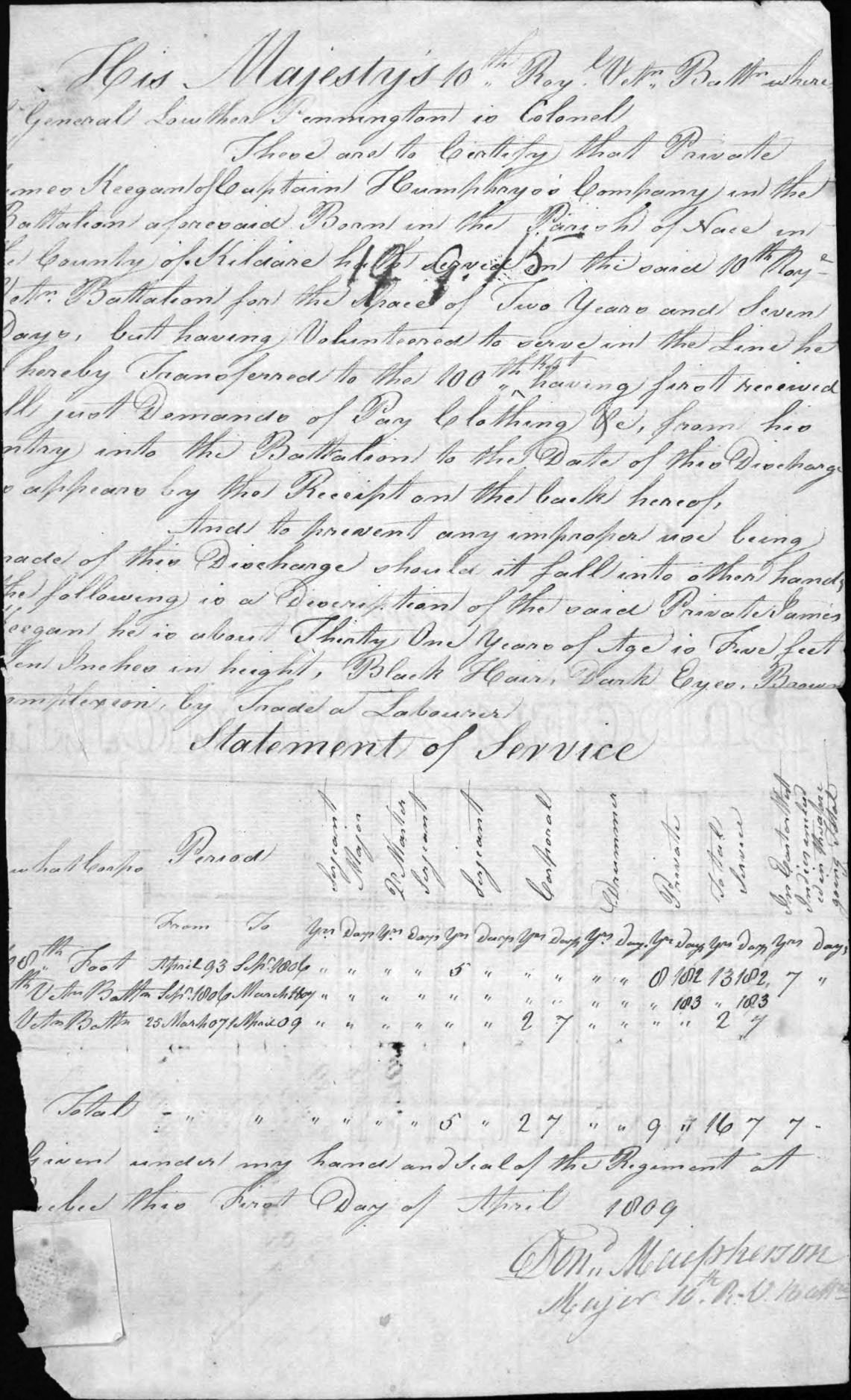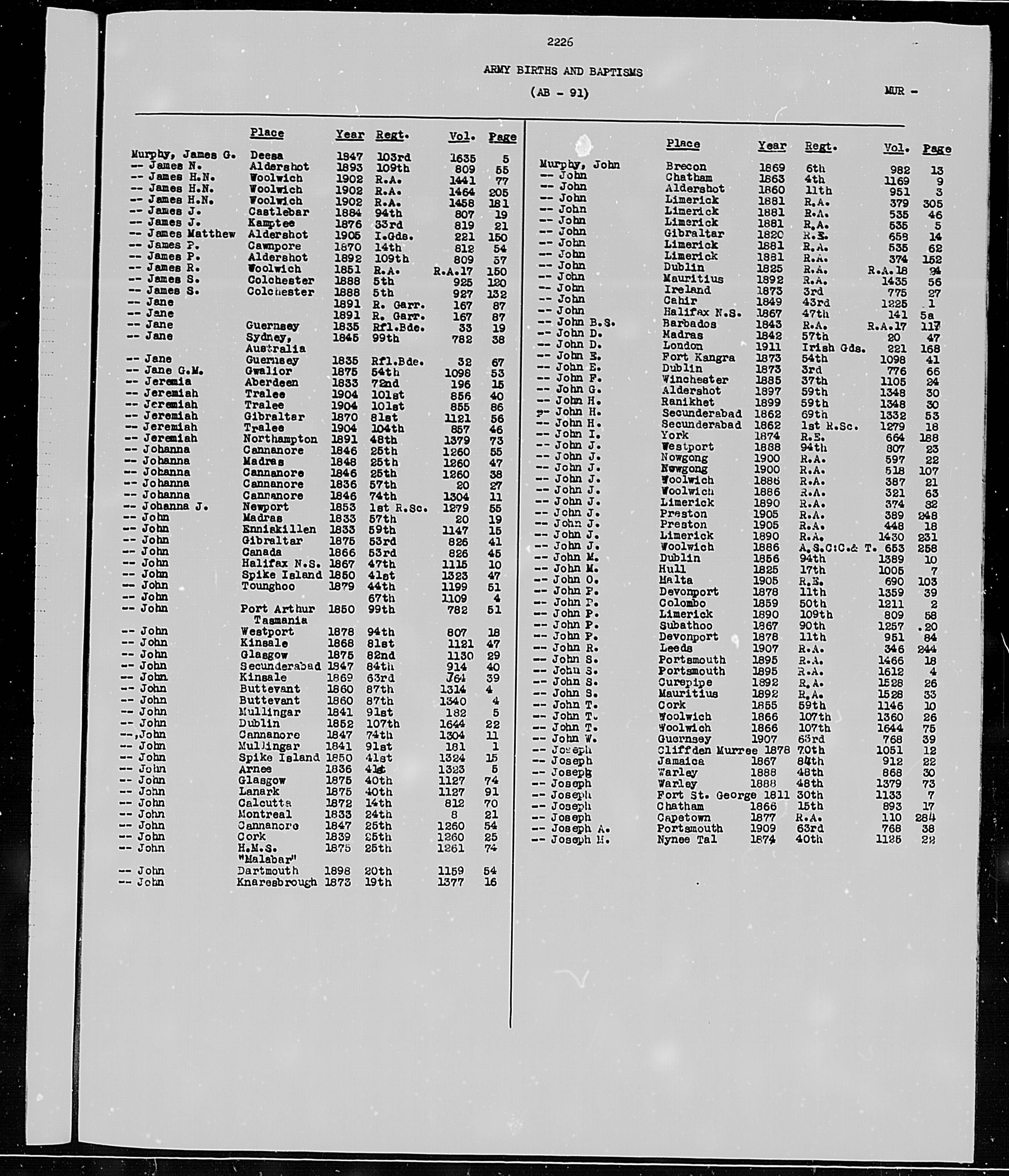Researching Irish Soldiers
RESEARCHING IRISHMEN IN THE BRITISH ARMY
Which records are relevant depends on whether your ancestor was a soldier or an officer and on the period in which they served. Almost all of the records are in the English National Archives. The biggest exception is for Guards regiments, who retain their own records. Many, but not all of TNA's records are online at ancestry.co.uk and FindMyPast.co.uk. Records before 1913 are generally searchable on FindMyPast, with records of the First World War and later generally on Ancestry, but there are numerous exceptions. The only complete account is in TNA's guides to army and militia records for family history at nationalarchives.gov.uk. For someone who served in the British army after 1920, a service record can be applied for at www.gov.uk. The best guide to records of Irish regiments in the British army is from the Irish Military Archives site), though you should keep in mind that Irishmen served throughout the army and not exclusively in the Irish regiments.Soldiers
From the late eighteenth century a very large proportion of the rank and file of the British army consisted of Irishmen: one estimate for the middle of the nineteenth century is 40 per cent.
Soldiers' documents (discharges)
WO 97 contains service records from the Royal Hospital Chelsea between 1760 and 1913 and can often provide details of place of birth, age and appearance, and, after 1882, next of kin. It is part of the 'Military, armed forces & conflict' collection on FindMyPast.co.uk. The records up to 1882 only cover soldiers discharged to pension; after that year all discharges are recorded. Before 1873 the records are organised by regiment, but a name index exists for the period 1760-1854. From 1873 to 1882 they are organised under the collective headings 'Artillery', 'Cavalry', 'Corps' and 'Infantry', and then within these alphabetically. From 1883 they are alphabetical. Many of the early discharge papers are summarised in the National Archives online catalogue, www.discovery.nationalarchives.gov.uk. It can be worth while simply to enter the name of the individual, or the county militia, in the National Archives search page and see what emerges.Only a minority of soldiers were actually discharged to pension; if your soldier does not appear in the soldiers' documents you many find him in one of the sources below.

Pension records
If a soldier was discharged to pension or as medically unfit in Ireland between 1760 and 1822, detailed information will be found in the registers of the Royal Hospital, Kilmainham, WO 119, which contain the Certificates of Service. These records are searchable by name in the National Archives online catalogue. Go to discovery.nationalarchives.gov.uk and confine the search under 'department or series code' or 'Reference' to WO 119. The Kilmainham records are also on 'FindMyPast.ie. In-pensioners' records (for those actually resident in the institution) go from 1704 to 1922 and are in WO 118. Irish out-pensioners (those receiving a pension but not resident) were administered from the Royal Hospital, Chelsea, after 1822 (WO 116 and 117, downloadable free from the TNA site as digital microfilm). The pension records (1760-1915) of the Royal Hospital, Chelsea, are on FindMyPast.co.uk. Regimental Registers of Admissions to Pension also exist, indexed from 1806 to 1836; otherwise, each regimental volume includes an index. The NAI also has microfilm copies of the Kilmainham records.You should remember that it was quite common for Irishmen to be discharged outside Ireland, in which case pension papers would be in the Chelsea records, even between 1760 and 1822, and that, again, only a minority of those who served are covered.
Pay lists and musters
Each regiment made a quarterly return of all personnel from the early eighteenth century to 1878. From the 1860s these also included details of wives and children living in married quarters. These are obviously much more comprehensive than the pensions and discharge records and can supply fascinating detail about individuals. TNA holds 13,307 volumes. The date of enlistment can be used to search the relevant muster, which should give birthplace, age and former occupation. The records are in WO 10, 11, 12 and 13. However, it is necessary to know the regiment before using these records, which can be a serious obstacle. A few are on FindMyPast.co.uk and Ancestry, but almost all are only available in TNA.Other records
Casualties and deserters:Soldiers who died on active service are recorded in the regimental returns of casualties from 1795 to 1875 in WO 25 and are indexed. Digital microfilm of WO 25 is free to download at the TNA site (goo.gl/7XehPp). Additional material such as wills, lists of effects and details of next of kin may also be found. The same series also includes details of absentees and registers of deserters for the first half of the nineteenth century. There is also an incomplete card index at the National Archives (Kew) to army deserters (1689-1830). FindMyPast.co.uk has Army Deserters 1828-1840.
Description Books
Also in WO 25 are the regimental description books - the earliest from 1756, the latest from 1900 - which give physical details as well as service history. They are not comprehensive and do not cover the entire period. The LDS Library has a large set of microfilms of WO 25 (familysearch.org/search/catalog/175494), only some of which are viewable or searchable.
Births, marriages and deaths.
The index to regimental registers of births, 1761-1924, gives the regiment and place of birth of children born to the wives of serving soldiers, if they were attached to the regiment. The indexes were online at FindMyPast,co.uk in the 'British Nationals Armed Forces Births 1761-2005' collection, but appear to have been removed. Full certificates can be ordered online at www.gro.gov.uk. The TNA site has free, digital microfilm copies of Navy indexes and registers of reports of deaths on ships between 1893 and 1950 (ADM 104). Composite army and navy birth, marriage and death records (1730-1960) taken from different TNA series are on Ancestry. Births of children to soldiers serving in nineteenth-century India, and marriages of these soldiers appear to be included in the FamilySearch collections 'India Births and Baptisms, 1786-1947 and 'India Marriages, 1792-1948', taken from the British India Office Ecclesiastical Returns.
Campaign medals 1793-1949
Campaign medal and award rolls (WO 100) are on Ancestry.co.uk.
Finding the Regiment
For most of the non-online pre-1873 records, knowing the regiment is vital. It can be quite difficult to uncover.
- 1. Uniforms: Wikipedia has an excellent list of British Army cavalry and infantry regiments for 1881. Also useful is D J Barnes, 'Identification and Dating: Military Uniforms', in Family History in Focus, edited by D J Steel and L Taylor (Guildford, 1984).
- 2. The Regimental Registers of Births (see above) can help if you have some idea of the names of children or the areas a soldier served in.
- 3. Wills of soldiers dying overseas were proved at the Prerogative Court of Canterbury (PROB 11). These are searchable online at discovery.nationalarchives.gov.uk. The registers of next of kin in WO 25 may also be useful.
- 4. If you have an idea where a soldier was stationed, and approximately when, J.M Kitzmiller's, In Search of the Forlorn Hope: A Comprehensive Guide to Locating British Regiments and their Records (Salt Lake City, 1988) will help you to identify which regiments were stationed where. Regiments.org, now accessible only via archive.org, in its pre-2010 incarnation also has deployment records for many regiments.
- 5. David Murphy's The Irish Brigades 1685-2006: a gazetteer of Irish military service, past and present, (Dublin, Four Courts Press, 2007 304 pp) is a comprehensive account of Irish regiments in foreign armies.
Later Records
The Irish Soldiers' and Sailors Fund:
This Fund was set up to provide cottages for Irishmen who had served in the armed forces during World War l and helped build over 4000 cottages up to the 1930s. In Northern Ireland, cottages were built up to 1952. The records are organised by place; there is no name index. The tenancy files 1920 -1977 are in AP 7.
Anglo-Boer War:
The GRO in Roscommon has an index to 'Deaths of Irish Subjects pertaining to the South African War (1898-1902)' in the deaths index for 1902. This is not included in the online versions. Certified copies of the original entries include regiment and rank. FindMyPast's 'Anglo-Boer War Records 1899-1902' is a composite collection from a multiplicity of sources.
First World War
Of the 61/2 million service records of servicemen in the First World War originally held at the War Office Record Store, more than 4 million were destroyed in the Second World War. Those that survived were charred or suffered water damage and are consequently unavailable for research. A microfilming project to make these records (generally known as the 'burnt documents') publicly accessible was completed in the summer of 2002, and the films are now available at the National Archives, through the LDS family history centres and online at ancestry.co.uk, which also has pension records, 1914-1920. More than 2 million individuals are covered, with a variety of records. Among the most common are attestation papers, which give information about name, address, date of birth and next of kin. TNA (discovery.nationalarchives.gov.uk), has the Medal Rolls Index Cards (1914-20) of the First World War. There is also a copy on Ancestry. As everyone who served got a medal, these are more comprehensive than the service records and include regiment and number. They should be the starting point of research on First World War service.
Ireland's Memorial Records (Dublin: 1923) is an eight-volume commemorative publication listing the Irish men and women killed during the war and those of other nationalities who died while serving with Irish regiments. It is not, however, a complete list of all Irishmen killed while serving. It also supplies the place of origin. Online at the Flanders Field Museum, imr.inflandersfields.be, and FindMyPast.ie.
The Commonwealth War Graves Commission
The commission maintains graves in more than 150 countries, covering more than 925,000 individuals--those members of the forces of the Commonwealth killed in the First and Second World Wars. Its website, www.cwgc.org, includes extensive details on those buried.
Irish Regiments
The enlistment books for 1920-22 for the five regiments disbanded after 1922 (The Connaught Rangers, the Leinster Regiment, the Royal Dublin Fusiliers, the Royal Irish Regiment and the Royal Munster Fusiliers) are online at the National Army Museum, www.nam.ac.uk/soldiers-records/persons.
